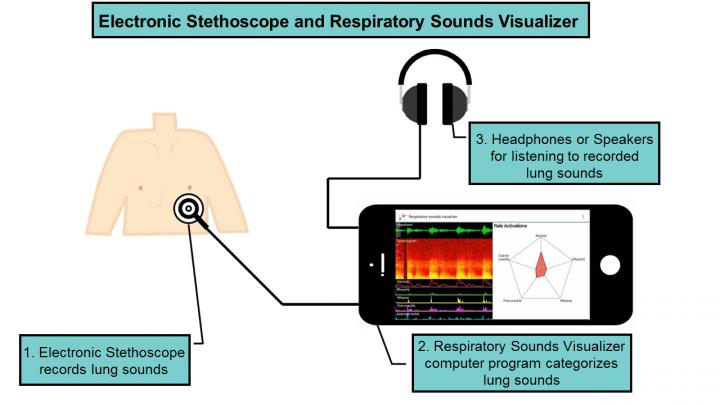The physician’s stethoscope, an iconic instrument of the medical profession, is being transitioned into the digital era. Scientists at Japan’s Hiroshima and Fukushima Medical Universities have developed a computer program that interfaces with an electronic stethoscope capable of classifying lung sounds into five common diagnostic categories.
Digital-Age Stethoscope: After the electronic stethoscope records patient’s breathing, lung sounds are sent to a smartphone or tablet and analyzed by the computer program, enabling medical professionals to listen to and view results in real time from any location to diagnose the patient. (Credit: Hiroshima University)
The Respiratory Sounds Visualizer computer program and the new electronic stethoscope device with a high sensitivity for lung sounds were developed by a team of three physician inventor-researchers at Hiroshima University and Fukushima Medical University, in collaboration with the Kawasaki-shi, Kanagawa-based multinational electronics company Pioneer Corporation.
The developmental research of this project was described in an article published in the journal Annals of Internal Medicine titled “Innovation in Analysis of Respiratory Sounds,“ co-authored by Shinichiro Ohshimo, M.D., Ph.D.; Takuma Sadamori, M.D., Ph.D.; and Koichi Tanigawa, M.D., Ph.D.
According to a Hiroshima University press release, lung sounds of 878 patients were recorded and classified by respiratory specialist doctors. The researchers then used these diagnoses to create templates based on a mathematical formula evaluating lung sounds in terms of length, intensity, and frequency. The computer program was engineered to recognize sound patterns consistent with different respiratory diagnoses.
The software analyzes the lung sounds and maps them on a five-sided chart displayed on a smartphone or tablet with each of the five axes representing one of the five lung sound categories. Doctors and patients can then view a chart readout showing which particular diagnosis is more likely.
With traditional analog stethoscopes, clinicians listening to heart and lung sounds are obliged to mentally tune out any ambient background noise and determine if a patient has one or multiple irregularities. However, with the electronic stethoscope and computer program combo, even when working in less-than-ideal circumstances such as a busy emergency room or a medical field hospital, doctors can rely on the computer program to “hear” sounds they might otherwise miss. In addition, the device’s ability to recognize when a patient has multiple lung problems simultaneously will benefit student doctors in the process of developing their own diagnostic expertise.
Besides being simple to interpret, results from the computer program can be saved or shared electronically, and in the future, this convenience may enable patients with chronic disorders like cystic fibrosis or chronic obstructive pulmonary disease (COPD) to self-track and record their own lung function.
The Respiratory Sounds Visualizer will soon be publicly available, according to Ohshimo, who works with patients in the Department of Emergency and Critical Care Medicine at Hiroshima University Hospital, and is one of the researchers involved in the development of the digital stethoscope technology.
“We plan to use the electronic stethoscope and Respiratory Sounds Visualizer with our own patients after further improving [the mathematical calculations]. We will also release the computer program as a downloadable application to the public in the near future,” Ohshimo said.


